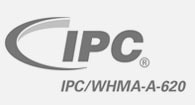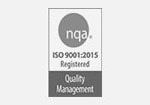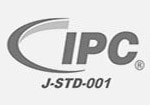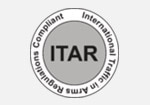Coaxial cables are a type of transmission cable used to transmit radio frequency (RF) signals. They generally consist of four layers—the inner conductor layer, the inner conductor insulating layer, the conductive shield layer, and the insulating outer jacket layer. This shielded design enables signal carrying voltage to flow through the central conductor with minimal interference from outside electrical and/or magnetic fields.
There are many types of coaxial cables available—varying in design and size—to suit different applications. One of the key design elements by which coaxial cables can be categorized is connector type—i.e., the mechanism that connects the cable to other devices. Below, we highlight the advantages and disadvantages of several common types of coaxial cable, based on connector, as well as their typical applications.
BNC
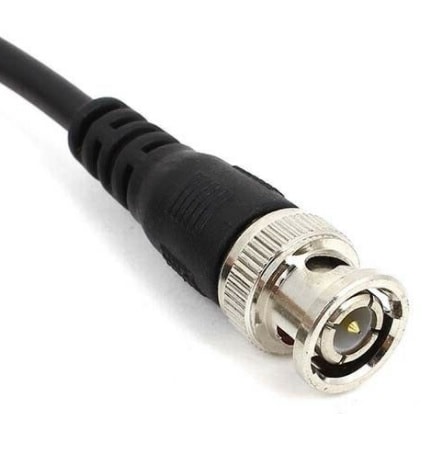 Bayonet Neill-Concelman (BNC) coaxial cable connectors are one of the most commonly used connector types. They feature a twist and snap bayonet connection design that requires a quarter-turn to form a connection.
Bayonet Neill-Concelman (BNC) coaxial cable connectors are one of the most commonly used connector types. They feature a twist and snap bayonet connection design that requires a quarter-turn to form a connection.
Key advantages of BNC connectors include:
- Simple design. They have the simplest design of all coax cable connectors.
- Easy connection. They do not require any tools.
- Small accidental disconnection risk. They lock the connection in place to prevent accidental disconnection caused by vibrations or other movements.
Some of the disadvantages include:
- Limited frequency range. They have a frequency range limited to DC-4 GHz.
- High susceptibility to variations. They can experience variations in resistance and outer sleeve connection when exposed to mechanical vibrations.
Typical applications include commercial audio/video transmission systems and RF test equipment (e.g., frequency generators, network analyzers, and oscilloscopes).
TNC
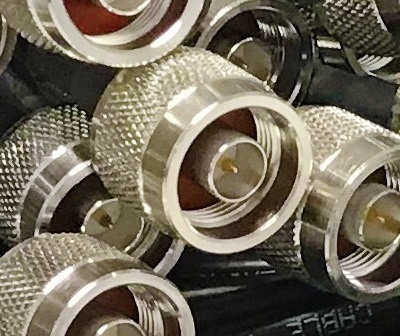 Threaded Neill-Concelman (TNC) connectors are a miniature threaded variation of BNC connectors. However, they are waterproof and more rugged.
Threaded Neill-Concelman (TNC) connectors are a miniature threaded variation of BNC connectors. However, they are waterproof and more rugged.
Key advantages of TNC connectors include:
- High frequency capacities. They can operate with frequencies up to 11 GHz.
- High mating cycle life. They can be used for up to and exceeding 500 cycles.
- Low susceptibility to variations. They are less likely to experience variations in resistance and outer sleeve connection when exposed to mechanical vibrations.
Some of the disadvantages include:
- Large size, heavy weight. They are heavier and larger than SMA connectors.
- Specific attachment requirements. They require a specific coaxial cable form.
- Potential for higher loss. Right-angled versions have a slightly higher level of loss than straight-through connectors, which can be a concern in applications involving frequencies near the operational limit of the connector.
Typical applications include mobile telephones and RF antennas.
SMA
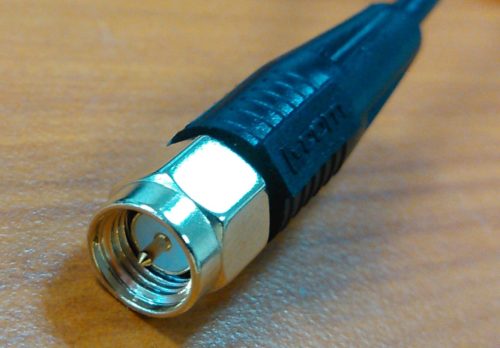 Subminiature Version A (SMA) connectors are 50 Ω connectors. They are available in several formats, including male vs. female, straight-through vs. right-angled, and more.
Subminiature Version A (SMA) connectors are 50 Ω connectors. They are available in several formats, including male vs. female, straight-through vs. right-angled, and more.
Key advantages of SMA connectors include:
- Small size, light weight. They are smaller and lighter than TNC connectors, making them suitable for applications where size and weight are a concern.
- High frequency capacities. They can operate with frequencies up to 18 GHz.
Some of the disadvantages include:
- Less robustness. They are less suitable for use in harsh environments than larger connectors.
- Unsuitable for frequent connection/disconnection. They are not designed for applications that require frequent connection and disconnection.
Typical applications include microwave systems, telecommunications equipment, and Wi-Fi antennas.
7/16 DIN
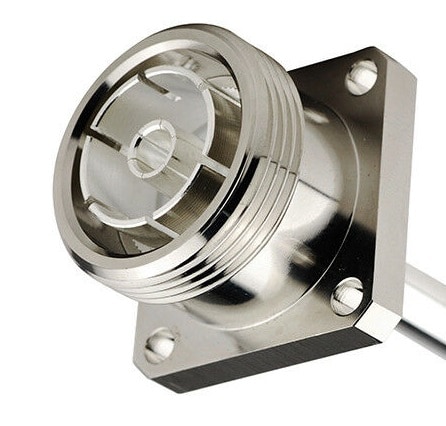 7/16 DIN (Deutsches Institut für Normung) connectors have a threaded design. They are typically used for high-wattage transmissions.
7/16 DIN (Deutsches Institut für Normung) connectors have a threaded design. They are typically used for high-wattage transmissions.
Key advantages of 7/16 DIN connectors include:
- High intermodulation rejection. They offer higher intermodulation rejection than BNC or N connectors.
- High power capacities. They handle higher power levels than most other connectors.
Some of the disadvantages include:
- Harder connection/disconnection requirements. They need a wrench for connection and disconnection.
- Incongruous with US standards. They are generally used in Europe rather than the United States.
Typical applications are base stations, broadcast communication systems, and other situations involving multiple transmissions.
QMA
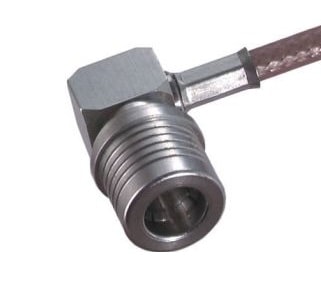 QMA connectors are similar to SMA connectors. However, they have a snap-lock design that allows for faster and easier connection/disconnection and 360° rotational capabilities after connection that allows for better installation flexibility.
QMA connectors are similar to SMA connectors. However, they have a snap-lock design that allows for faster and easier connection/disconnection and 360° rotational capabilities after connection that allows for better installation flexibility.
Other key advantages of QMA connectors include:
- High power capacities. They can handle higher power levels than some of the other connector types.
- High frequency capacities. They can operate with frequencies up to 18 GHz.
Their primary disadvantage is the lack of waterproofing. They are not suitable for use in environments where exposure to moisture is expected. However, they are ideal for use in industrial and communications applications that require the maintenance of the shielding barrier.
MCX
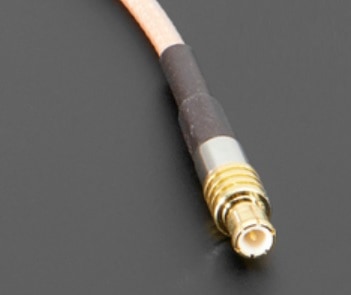 Micro coaxial (MCX) connectors are small form-factor connectors. They are designed for use in applications with size or space limitations.
Micro coaxial (MCX) connectors are small form-factor connectors. They are designed for use in applications with size or space limitations.
Key advantages of MCX connectors include:
- Similar to SMB connectors but are 30% smaller.
- Easy installation. They have a snap-on coupling design that makes installation simple and quick.
Some of the disadvantages include:
- Limited frequency range. They have a frequency range limited to DC-6 GHz.
- Variable sizes. They can vary in size depending on the manufacturer.
Typical applications include digital cellular systems, global positioning systems (GPS) devices, RF hardware, and TV tuner cards.
RCA
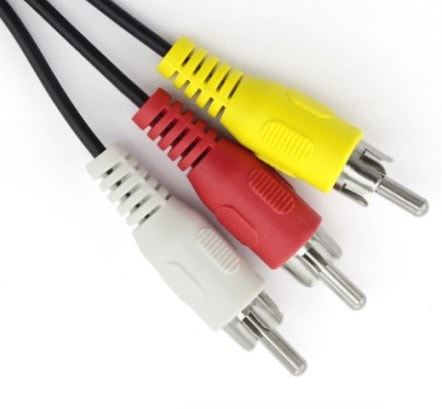 Radio Corporation of America (RCA) connectors are also known as cinch connectors. They typically feature three color-coded jacks and plugs (Red, Yellow, and White).
Radio Corporation of America (RCA) connectors are also known as cinch connectors. They typically feature three color-coded jacks and plugs (Red, Yellow, and White).
Key advantages of RCA connectors include:
- Wide availability. They are readily available.
- Low cost. They are relatively inexpensive.
The main disadvantage is the color code system. It can be difficult for some users to navigate, especially in more complex systems.
Typical applications include audio and video systems, such as camcorders, digital cameras, stereo systems, and televisions.
Partner With Electro-Prep for Your Coaxial Cable Needs!
Looking for a coaxial cable for your RF application? The experts at Electro-Prep are here to help! As a premier coaxial cable manufacturer, we are fully aware of the impact poorly designed and constructed cables can have on product performance. That’s why we employ a highly experienced and fully trained team who are committed to providing you with the highest quality cable solution. To learn more about our coaxial cable capabilities or discuss your requirements with one of our team members, contact us or request a quote today.



